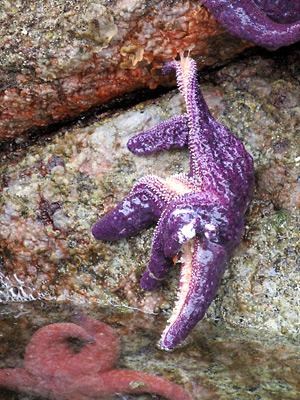Scientists think they may have cracked the mystery surrounding BC’s melting sea stars.
Over the past 18 months, sea stars on the Pacific coast from BC to Mexico have been dying by the millions.
Proceedings of the National Academy of Science, a well-respected science journal, published findings from a team of marine biologists at New York State’s Cornell University who specialize in ocean viruses.
Marine microbiologist Ian Hewson explained the wasting syndrome among sea stars is likely caused by a variety of densovirus. Varieties of this virus group are used as biological control for cockroaches and include parovirus which affects dogs.
Twenty different species of sea star have been affected by the virus, but three species, the common purple (Pisaster ochraceus), the leather star (Dermasterias imbricata) and sunflower star (Pycnopodia helianthoides) have been hardest hit.
The virus causes sea stars to be covered with white lesions and cripples the invertebrates’ vascular system which gives them the ability to attach to the sides of rocks.
Healthy sea stars, once infected, lose their arms and disintegrate into puddles of mush, leaving only a pile of small bones behind.
According to the peer-reviewed study, researchers found larger amounts of densovirus in sick sea stars than healthy ones. And the amount of virus increased as an infected sea star’s condition worsened.
Hewson said researchers looked at viruses as an explanation when sea stars became sick in aquariums that drew water from the ocean. The disease did not affect sea stars in aquariums where ocean water was treated with ultraviolet (UV) light. UV radiation is used in water purification systems as a method to disinfect water.
He said the study team does not know what triggered the outbreak of the virus which can also be found in plankton, sandy ocean bottoms and sea urchins and has been found in sea star specimens dating back to 1942.
Not all scientists are in agreement with the study findings, however.
Jeff Marliave, vice-president of marine science at Vancouver Aquarium, said the densovirus undoubtedly plays a role in the the sunflower sea stars dying en masse, but added that the situation is also more complex than just the effect of a viral outbreak.
“Pestilence is a normal levelling factor,” said Marliave. While the adult sunflower sea stars were hardest hit, the newborns which were also “filthy with virus,” were not affected, he said. “We don’t quite know how this virus affects them.”
Marliave added that at the turn of the millennium there was a population explosion of the sunflower sea stars, which could be affected by the regular changes in ocean currents.
“We are seeing a recovery of that species and none of the other species affected were completely wiped out,” he said.
Outbreaks of sea star wasting have been documented in the past, but were smaller and more confined in geographic area. Scientists have traced the current outbreak’s origin to the southern Californian coastline during the summer of 2013. By September 2013 divers off the coast of Vancouver Island were reporting encountering stars infected with the wasting disease.
What scientists agree on is the effect that this event will have on the marine food web.
Mussels and green sea urchins, both favourites in sunflower sea star dining, have become more abundant because of the die-off. Sea urchins eat kelp and seaweed so without a check on their numbers there will be less seaweed available for spot prawns, said Marliave.
“We don’t know where it’s going to wind up,” he said. “But it’s having some pretty far-reaching consequences for Howe Sound and probably the whole Strait of Georgia.”
~ with files from Canadian Press



